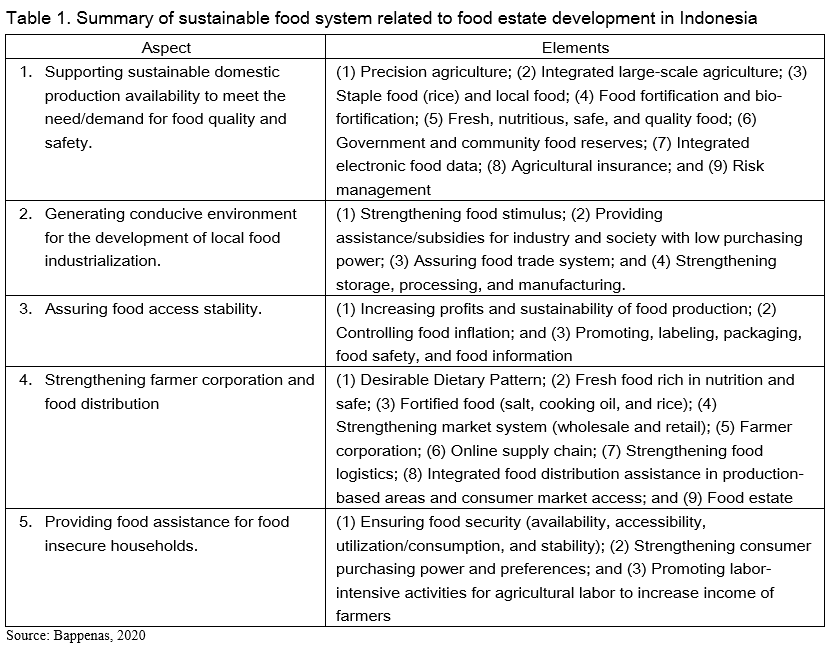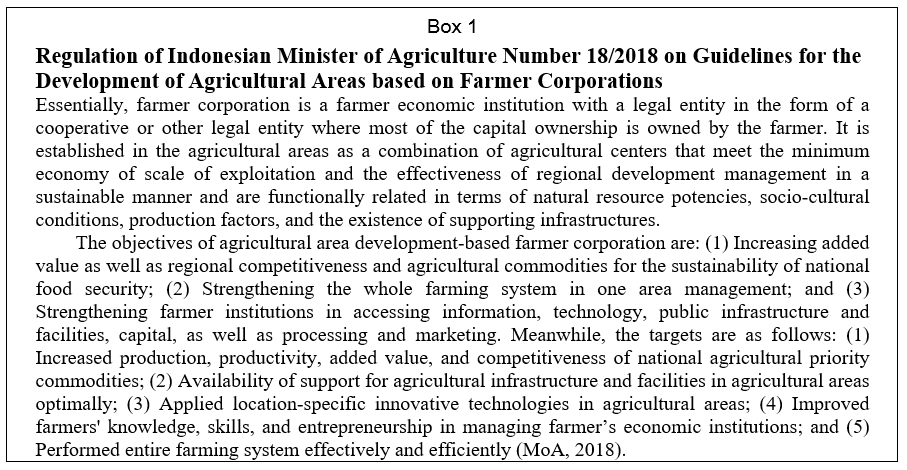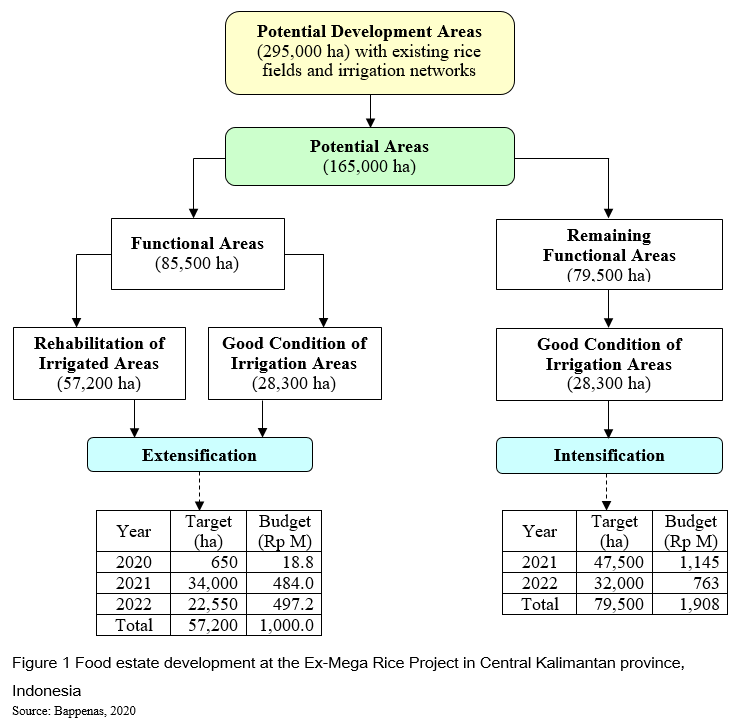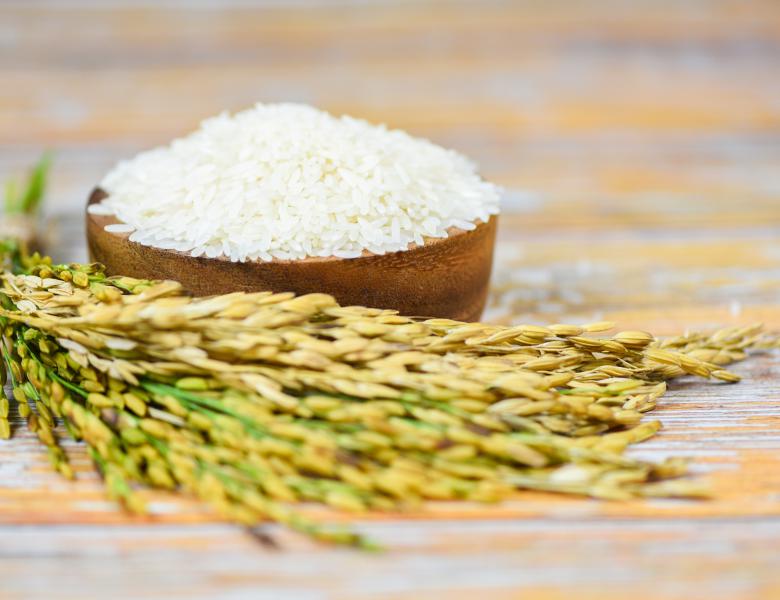ABSTRACT
This article aims to discuss food estate development policy program to support sustainable food system in Indonesia. The food system-based food estate includes: (1) food availability, quality, and safety; (2) food industrialization; (3) food accessibility; (4) food distribution; and (5) food assistance. Food estate is developed through integrating food based-food crops, horticulture, estate crops, and livestock involving multi stakeholders. Currently, food estate development is being implemented in Central Kalimantan province. This is a big vision to achieve national food security in the country. Hence, it requires strong and serious support and commitment from stakeholders at the central and local levels to develop food estate sustainably.
Keywords: food systems, food security, food estate, development, Indonesia
INTRODUCTION
It is believed that feeding the growing population is not a simple way, including Indonesia. Therefore, the country considers food as an essential issue in nation building towards fulfilling primary basic human needs as part of human rights for every people. With regard to this issue, the Government of Indonesia (GoI) has established the Food Law Number 18/2012 which includes food system.
Food system is fundamentally organized to fulfill the basic human necessity, providing benefit in a justice, equitable, and sustainable manner based on food sovereignty, self-reliance, and security. One of the programs related to food system is food estate. This program is basically aimed at maintaining the long-term food security as a food development concept which is carried out in an integrated manner particularly in agricultural areas.
This article discusses food estate development policy program that supports sustainable food system in Indonesia. It includes the substance of food system as well as the policy framework and implementation of food estate development in the country.
FOOD SYSTEM
Following the definition of FAO, food system gathers all the elements (environment, people, inputs, processes, infrastructures, institutions, etc.) and activities that relate to the production, processing, distribution, preparation and consumption of food, as well as the outputs of these activities, including socioeconomic and environmental outcomes. Moreover, the essence of food system is its sustainability which is defined as follows: “Sustainable food system is a food system that delivers food security and nutrition for all in such a way that the economic, social, and environmental bases to generate food security and nutrition for future generations are not compromised” (HLPE, 2014).
In the context of Indonesia, the national sustainable food system which is particularly related to food estate development simply comprises of the following: (1) Supporting sustainable domestic production availability to meet the need/demand for food quality and safety; (2) Generating conducive environment for the development of local food industrialization; (3) Assuring food access stability; (4) Strengthening farmer corporation and food distribution; and (5) Providing food assistance for food insecure households. This concept is summarized in Table 1.

FOOD ESTATE
Conceptually, food estate refers to food development which is carried out in an integrated manner covering agricultural sub-sector (food crops, horticulture, estate crops, and livestock) in particular areas. It is an industrial system-based science and technology, capital, as well as contemporary organization and management.
The basic concept of food estate is based on the integration of sectors and sub-sectors in agribusiness system by utilizing optimal and sustainable resources, professional management, supported by quality human resources, appropriate technology that is environmentally sound, and strong institutions. It is directed to agribusiness system which is deeply rooted in rural areas based on empowerment of local communities as the basis for regional development (IAARD, 2011).
Policy framework of food estate development
It is underlined that food estate differs from rice estate. The former is carried out to develop integrated food based-food crops, horticulture, estate crops, and livestock, while the latter simply focuses on rice commodity. The basis of food estate development is the Regulation of Indonesian Minister of Agriculture Number 18/2018 (Box 1).
The food estate is an extraordinary activity developed in a modern and business-oriented manner from upstream to downstream by utilizing modern technology based on corporation of farmers of which all resources are managed optimally through clustering business scheme. Hence, there are three levels of food estate business development, namely: (1) Individual farmer business level; (2) Cooperative business level; and (3) Corporate business level.
The food estate development comprises of six criteria (Bappenas, 2020). They are: (1) Formal legal criteria (layout, ownership, management, and tenure systems); (2) Environmental criteria (soil, water, and agro-climate); (3) Infrastructure criteria (irrigation, energy, transportation, and logistics); (4) Cultivation criteria (growing environment, agronomic, production facilities, and production technology based-good agricultural practices); (5) Social and human resource criteria (demographics, employment, and productive sector activities); and (6) Technology criteria (type, level, suitability, as well as on-farm, off-farm, and processing industries feasibility and sustainability). Those are managed into groups representing commodity based-zone development area of food crops, horticulture, estate crops, and livestock through particular approaches (Table 2).

The objectives, targets, and benefits of food estate development are presented in Table 3. Those generally include the aspects of production, technology, infrastructure and facilities, institutional representative, and other related entities toward food security achievement.

Implementation of food estate development
Institutionally, the implementation of food estate development involves certain institutions, namely the Ministry of Agriculture (MoA), Ministry of Public Works and Public Housing (PUPR), Ministry of State Owned Enterprises (BUMN), and Ministry of Defense. The MoA remains fully responsible for the aspects of cultivation from pre to post harvests in order to increase production both in quantity and quality if necessary so that it can be exported. The Ministry of PUPR plays a role or supports in the development of primary and secondary irrigation, while tertiary irrigation is under the responsiblity of the MoA. The Ministry of BUMN organizes an investment scheme. Meanwhile, the Ministry of Defense carries out National Armed Force (TNI) particularly its Village Sub-sector Command which has a strong supervisory function in the field.
The implementation of food estate development is carried out based on economic of scale, namely an area of 10,000 hectares with a cluster of 1,000 hectares. It is developed by two-model, specifically: (1) Medium-scale development with an intensification approach; and (2) Large-scale development with an extensification approach. It is planned to be developed in five provinces with the total areas of about 1,700,000 hectares (Table 4).
Currently, food estate development is being implemented in Central Kalimantan province, namely the Ex-Mega Rice Project[1] of Peat Land Development. It is not reopening the area, but optimizing the use of existing and not existing areas. This province is selected due to significantly increased agricultural productivity considerably in line with its advantage and limitations towards improving the cropping index and productivity. It is noted that the development of food estate particularly in Java would not be able to achieve the national food security significantly.


CONCLUSION
Indonesia has a big vision to achieve food security through developing food estate. It is being developed to strengthen national food reserve both at upstream and downstream industrial food products. There are five keys of food estate development, namely: (1) business model implementation; (2) capital investments; (3) human resources involvement; (4) management service; and (5) assessments application.
The development of food estate-based farmer corporation has a strategic role in increasing food production and welfare of farmers. It would increase national food security and optimize the use of resources as well as open business opportunities in a more rational and efficient manner. There is a need for business cooperation among stakeholders to optimize resource management in more integrated and sustainable approaches.
Food estate development is carried out in an integrated and gradual scheme and managed by creative and innovative corporate farmer management toward realizing the advanced, independent, modern, and sustainable food crop production system. It is supported by using technological innovation to which it will be able to produce and market a variety of food crop products more efficiently with high quality standards. Within food estate development, it is expected that food diversification, added value, competitiveness, and income of farmers would be improved considerably. Hence, it requires strong and serious support and commitment from representative stakeholders at the central and local levels to develop food estate sustainably.
REFERENCES
Bappenas. 2020. Pengembangan Food Estate di Kalimantan Tengah (Food Estate Development in Central Kalimantan). National Development Planning Agency of Indonesia. Jakarta.
HLPE, 2014. Food Losses and Waste in the Context of Sustainable Food Systems. High Level Panel of Experts on Food Security and Nutrition, United Nations Committee on World Food Security. Rome. http:// www.fao.org /3/a-i3901e.pdf (1 October 2020).
IAARD.2011. Buku Pintar Food Estate (Food Estate Smart Book). Indonesian Agency for Agricultural Research and Development. Jakarta. http//www.litbang. pertanian go.id/ info-aktual/819/file/Bagian-1.pdf (1 October 2020).
Indonesiabaik.id. 2020. Food Estate: Pangan Melimpah, Harga Lebih Murah (Food Estate: Abundant Food, Cheaper Prices). http://indonesiabaik.id/infografis/food-estate#:~:text =Untuk%20menjaga%20ketahanan%20pangan%20Indonesia,bahkan%20peternakan%20di%20suatu%20kawasan.(26 September 2020)
MoA. 2018. Peraturan Menteri Pertanian Nomor 18/2018 tentang Pedoman Pengembangan Kawasan Pertanian Berbasis Korporasi Petani (Indonesian Minister of Agriculture Regulation Number 18/2018 on Guidelines for Agricultural Development Area-based Corporate Farmers). Indonesian Minister of Agriculture. Jakarta.
MoA. 2020. Pedoman Umum Pengembangan Kawasan Food Estate Berbasis Korporasi Petani di Lahan Rawa Kalimantan Tengah (General Guidelines for Corporate Farmers Development-base Food Estate Areas in Swamp Land of Central Kalimantan). Indonesian Minister of Agriculture. Jakarta.
OTPP. 2011. Ex-Mega Rice Project Gibbon Density and Comparison with Other Areas. The Orangutan Tropical Peatland Project. http://www.borneonature foundation.org/ wp content/uploads/2016/01/cheyne_gibbon_density_comparisons_report.pdf (1 October 2020).
[1] This project was initiated in 1996 in Central Kalimantan province with the goal of clear-felling one million hectares of unproductive and sparsely populated lowland peat-swamp forest into rice fields in an attempt to alleviate Indonesia’s growing food shortage. The government made a large investment in constructing irrigation canals and other supported infrastructure and facilities. Nevertheless, the project did not succeed, and was eventually abandoned after causing considerable technical and socioeconomic problems (OTPP, 2011).



Supporting Sustainable Food Systems-Based Food Estate Development Policy Program in Indonesia
ABSTRACT
This article aims to discuss food estate development policy program to support sustainable food system in Indonesia. The food system-based food estate includes: (1) food availability, quality, and safety; (2) food industrialization; (3) food accessibility; (4) food distribution; and (5) food assistance. Food estate is developed through integrating food based-food crops, horticulture, estate crops, and livestock involving multi stakeholders. Currently, food estate development is being implemented in Central Kalimantan province. This is a big vision to achieve national food security in the country. Hence, it requires strong and serious support and commitment from stakeholders at the central and local levels to develop food estate sustainably.
Keywords: food systems, food security, food estate, development, Indonesia
INTRODUCTION
It is believed that feeding the growing population is not a simple way, including Indonesia. Therefore, the country considers food as an essential issue in nation building towards fulfilling primary basic human needs as part of human rights for every people. With regard to this issue, the Government of Indonesia (GoI) has established the Food Law Number 18/2012 which includes food system.
Food system is fundamentally organized to fulfill the basic human necessity, providing benefit in a justice, equitable, and sustainable manner based on food sovereignty, self-reliance, and security. One of the programs related to food system is food estate. This program is basically aimed at maintaining the long-term food security as a food development concept which is carried out in an integrated manner particularly in agricultural areas.
This article discusses food estate development policy program that supports sustainable food system in Indonesia. It includes the substance of food system as well as the policy framework and implementation of food estate development in the country.
FOOD SYSTEM
Following the definition of FAO, food system gathers all the elements (environment, people, inputs, processes, infrastructures, institutions, etc.) and activities that relate to the production, processing, distribution, preparation and consumption of food, as well as the outputs of these activities, including socioeconomic and environmental outcomes. Moreover, the essence of food system is its sustainability which is defined as follows: “Sustainable food system is a food system that delivers food security and nutrition for all in such a way that the economic, social, and environmental bases to generate food security and nutrition for future generations are not compromised” (HLPE, 2014).
In the context of Indonesia, the national sustainable food system which is particularly related to food estate development simply comprises of the following: (1) Supporting sustainable domestic production availability to meet the need/demand for food quality and safety; (2) Generating conducive environment for the development of local food industrialization; (3) Assuring food access stability; (4) Strengthening farmer corporation and food distribution; and (5) Providing food assistance for food insecure households. This concept is summarized in Table 1.
FOOD ESTATE
Conceptually, food estate refers to food development which is carried out in an integrated manner covering agricultural sub-sector (food crops, horticulture, estate crops, and livestock) in particular areas. It is an industrial system-based science and technology, capital, as well as contemporary organization and management.
The basic concept of food estate is based on the integration of sectors and sub-sectors in agribusiness system by utilizing optimal and sustainable resources, professional management, supported by quality human resources, appropriate technology that is environmentally sound, and strong institutions. It is directed to agribusiness system which is deeply rooted in rural areas based on empowerment of local communities as the basis for regional development (IAARD, 2011).
Policy framework of food estate development
It is underlined that food estate differs from rice estate. The former is carried out to develop integrated food based-food crops, horticulture, estate crops, and livestock, while the latter simply focuses on rice commodity. The basis of food estate development is the Regulation of Indonesian Minister of Agriculture Number 18/2018 (Box 1).
The food estate is an extraordinary activity developed in a modern and business-oriented manner from upstream to downstream by utilizing modern technology based on corporation of farmers of which all resources are managed optimally through clustering business scheme. Hence, there are three levels of food estate business development, namely: (1) Individual farmer business level; (2) Cooperative business level; and (3) Corporate business level.
The food estate development comprises of six criteria (Bappenas, 2020). They are: (1) Formal legal criteria (layout, ownership, management, and tenure systems); (2) Environmental criteria (soil, water, and agro-climate); (3) Infrastructure criteria (irrigation, energy, transportation, and logistics); (4) Cultivation criteria (growing environment, agronomic, production facilities, and production technology based-good agricultural practices); (5) Social and human resource criteria (demographics, employment, and productive sector activities); and (6) Technology criteria (type, level, suitability, as well as on-farm, off-farm, and processing industries feasibility and sustainability). Those are managed into groups representing commodity based-zone development area of food crops, horticulture, estate crops, and livestock through particular approaches (Table 2).
The objectives, targets, and benefits of food estate development are presented in Table 3. Those generally include the aspects of production, technology, infrastructure and facilities, institutional representative, and other related entities toward food security achievement.
Implementation of food estate development
Institutionally, the implementation of food estate development involves certain institutions, namely the Ministry of Agriculture (MoA), Ministry of Public Works and Public Housing (PUPR), Ministry of State Owned Enterprises (BUMN), and Ministry of Defense. The MoA remains fully responsible for the aspects of cultivation from pre to post harvests in order to increase production both in quantity and quality if necessary so that it can be exported. The Ministry of PUPR plays a role or supports in the development of primary and secondary irrigation, while tertiary irrigation is under the responsiblity of the MoA. The Ministry of BUMN organizes an investment scheme. Meanwhile, the Ministry of Defense carries out National Armed Force (TNI) particularly its Village Sub-sector Command which has a strong supervisory function in the field.
The implementation of food estate development is carried out based on economic of scale, namely an area of 10,000 hectares with a cluster of 1,000 hectares. It is developed by two-model, specifically: (1) Medium-scale development with an intensification approach; and (2) Large-scale development with an extensification approach. It is planned to be developed in five provinces with the total areas of about 1,700,000 hectares (Table 4).
Currently, food estate development is being implemented in Central Kalimantan province, namely the Ex-Mega Rice Project[1] of Peat Land Development. It is not reopening the area, but optimizing the use of existing and not existing areas. This province is selected due to significantly increased agricultural productivity considerably in line with its advantage and limitations towards improving the cropping index and productivity. It is noted that the development of food estate particularly in Java would not be able to achieve the national food security significantly.
CONCLUSION
Indonesia has a big vision to achieve food security through developing food estate. It is being developed to strengthen national food reserve both at upstream and downstream industrial food products. There are five keys of food estate development, namely: (1) business model implementation; (2) capital investments; (3) human resources involvement; (4) management service; and (5) assessments application.
The development of food estate-based farmer corporation has a strategic role in increasing food production and welfare of farmers. It would increase national food security and optimize the use of resources as well as open business opportunities in a more rational and efficient manner. There is a need for business cooperation among stakeholders to optimize resource management in more integrated and sustainable approaches.
Food estate development is carried out in an integrated and gradual scheme and managed by creative and innovative corporate farmer management toward realizing the advanced, independent, modern, and sustainable food crop production system. It is supported by using technological innovation to which it will be able to produce and market a variety of food crop products more efficiently with high quality standards. Within food estate development, it is expected that food diversification, added value, competitiveness, and income of farmers would be improved considerably. Hence, it requires strong and serious support and commitment from representative stakeholders at the central and local levels to develop food estate sustainably.
REFERENCES
Bappenas. 2020. Pengembangan Food Estate di Kalimantan Tengah (Food Estate Development in Central Kalimantan). National Development Planning Agency of Indonesia. Jakarta.
HLPE, 2014. Food Losses and Waste in the Context of Sustainable Food Systems. High Level Panel of Experts on Food Security and Nutrition, United Nations Committee on World Food Security. Rome. http:// www.fao.org /3/a-i3901e.pdf (1 October 2020).
IAARD.2011. Buku Pintar Food Estate (Food Estate Smart Book). Indonesian Agency for Agricultural Research and Development. Jakarta. http//www.litbang. pertanian go.id/ info-aktual/819/file/Bagian-1.pdf (1 October 2020).
Indonesiabaik.id. 2020. Food Estate: Pangan Melimpah, Harga Lebih Murah (Food Estate: Abundant Food, Cheaper Prices). http://indonesiabaik.id/infografis/food-estate#:~:text =Untuk%20menjaga%20ketahanan%20pangan%20Indonesia,bahkan%20peternakan%20di%20suatu%20kawasan.(26 September 2020)
MoA. 2018. Peraturan Menteri Pertanian Nomor 18/2018 tentang Pedoman Pengembangan Kawasan Pertanian Berbasis Korporasi Petani (Indonesian Minister of Agriculture Regulation Number 18/2018 on Guidelines for Agricultural Development Area-based Corporate Farmers). Indonesian Minister of Agriculture. Jakarta.
MoA. 2020. Pedoman Umum Pengembangan Kawasan Food Estate Berbasis Korporasi Petani di Lahan Rawa Kalimantan Tengah (General Guidelines for Corporate Farmers Development-base Food Estate Areas in Swamp Land of Central Kalimantan). Indonesian Minister of Agriculture. Jakarta.
OTPP. 2011. Ex-Mega Rice Project Gibbon Density and Comparison with Other Areas. The Orangutan Tropical Peatland Project. http://www.borneonature foundation.org/ wp content/uploads/2016/01/cheyne_gibbon_density_comparisons_report.pdf (1 October 2020).
[1] This project was initiated in 1996 in Central Kalimantan province with the goal of clear-felling one million hectares of unproductive and sparsely populated lowland peat-swamp forest into rice fields in an attempt to alleviate Indonesia’s growing food shortage. The government made a large investment in constructing irrigation canals and other supported infrastructure and facilities. Nevertheless, the project did not succeed, and was eventually abandoned after causing considerable technical and socioeconomic problems (OTPP, 2011).